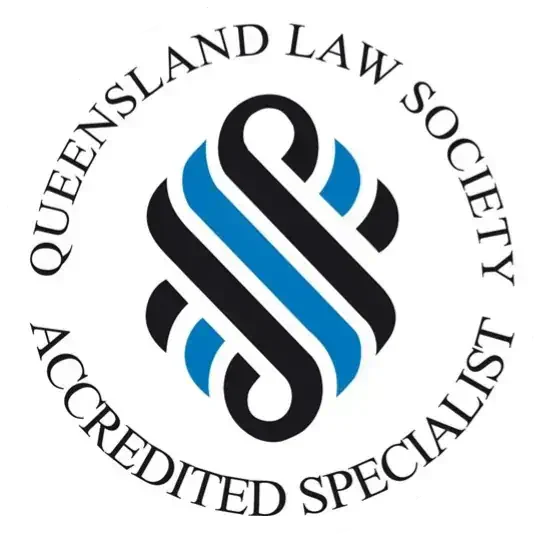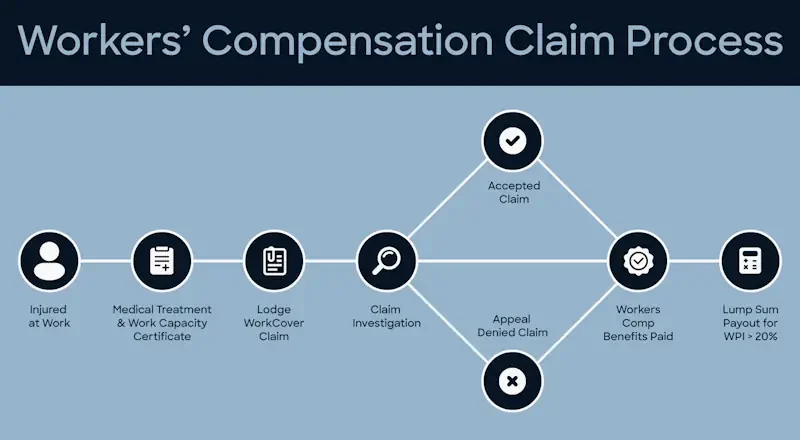A work injury damages claim is a common law legal action that arises when an employer’s negligence causes a work-related injury to an employee. We explain the QLD workers’ compensation scheme and the calculation of work injury compensation, which includes pain and suffering compensation, in our legal guide.
The Workers Compensation Lawyers QLD offer a free initial consultation of work injury claims that can explain your entitlements. All our workplace injury legal services come with a genuine 100% no-win, no-fee, no-risk guarantee. Pay only for a win and nothing if you lose. It’s free to learn your options.


Kerry Splatt – Law Firm Principal
Settlement of work injury damages is a one-time lump sum compensation payment that is the final resolution of a workers’ compensation claim. In Queensland, a claim for work injury damages can only succeed when the injuries sustained were the result of employer negligence.
Answer a few questions to learn your eligibility for workers’ compensation benefits. If you get stuck, please Call 1800 575 023
Workers injured physically or psychologically can be eligible for workers’ compensation benefits under the Workers’ Compensation Act in the following situations:
Several key factors determine eligibility to claim compensation for work injury damages.
Independent legal advice can explain whether you meet the requirements for a work injury claim. The Workers’ Compensation and Rehabilitation Act 2003 gives you the right to seek legal advice about eligibility for personal injury claims including common law entitlements.
The Workers’ Compensation Lawyers QLD offer a free case review, and our qualified personal injury lawyers work with the guidance of Kerry Splatt, a QLD Accredited Specialist in Personal Injury Law.
Furthermore, all our workers’ compensation legal services are funded on a 100% no-win, no-fee basis, with capped legal costs. Pay only after a win and nothing if you lose. Call 1800 575 023
How much workers’ compensation you receive for work injury common law claims relies on several factors, including the following:
Calculations for a work-related injury lump sum payout consider both economic and non-economic damages, including:
A final work injury damages settlement can also consider the value of weekly benefits already paid as workers’ compensation. Personal injury lawyers can provide expert legal advice that explains how ‘heads and damages’ apply to a workplace injury case.


Virtually any physical injury or recognised mental illness can prevent injured workers from earning an income, making them eligible for weekly payments and other workers’ compensation benefits. Those caused by employer negligence can also qualify for a lump sum payout.
Physical injuries in the workplace can result from:
Some common work-related physical injuries include:
Higher compensation is typically awarded for more serious injuries with long-lasting effects, such as a back injury.
Psychological injuries can disrupt your life just as much as physical ones. However, QLD WorkCover may deny claims for psychological injury due to the challenges associated with proving them. Psychological injuries in the workplace can result from:
A work injury damages claim assessment helps you understand if you have a valid claim and your entitlements. Using this straightforward workers’ compensation tool involves responding to some questions and then submitting your details. One of our personal injury lawyers will then review your circumstances and advise you on your rights and options.
The calculation of a lump sum amount involves considering the following factors:
Completing an assessment means you can learn your entitlements under the current Workers’ Compensation scheme. Additionally, the Workers Compensation Lawyers QLD can provide an estimated work injury damages settlement value during a free case review. Call 1800 575 023
Accurately determining eligibility and potential settlement values requires a thorough understanding of the variables that influence a work injury compensation claim. When approved, compensation provides workers’ compensation benefits and also covers various losses, including:
The number, type and severity of injuries significantly determine the compensation amount, with the ISV scale awarding higher payouts to more severe injuries.
Compensation values are largely determined by the degree to which injuries affect work capacity and the extent to which they disrupt daily life. This includes both permanent and temporary impairments, with the degree of impairment being critical in the calculation.
Most claimants nearing the end of their workers’ compensation claims will undergo a whole-person impairment assessment, which is an independent medical examination designed to evaluate the extent of long-term damage or functional decline resulting from a psychological or physical injury or illness.
A whole-person impairment assessment can result in a lump sum compensation payout reflecting the injury’s long-term consequences, significantly impacting the final settlement value.
Workers’ compensation common law claims allow injured workers to seek compensation beyond statutory workers compensation benefits when employer negligence caused their injuries. Unlike statutory claims, which provide fixed entitlements, common law claims consider the full extent of the injured worker’s losses.
To successfully prove a common law claim the injured worker must:
Workers injured by employer negligence can pursue both a WorkCover lump sum payout and common law claims when they have a permanent impairment of 20% or more. For ratings below 20% they must choose one or the other.
Economic losses in a workplace injury claim include past loss and future lost income and superannuation.
Loss of superannuation payments due to an inability to work can also be claimed. A major part of total compensation is economic losses, which must be carefully calculated in order to ensure fair compensation.

Non-economic losses in a workplace injury claim includes consideration of:
Often linked with a physical injury, this compensation component considers the emotional trauma and psychological suffering of an injured worker.
Calculating pain and suffering payout values is a complex process because it considers factors like emotional distress and overall impact on well-being. Hence, a detailed diagnosis from a qualified professional is crucial for psychological injuries.
When injuries sustained at work lead to long-term or permanent disability, you might be eligible to claim a lump sum payment through the insurance within your superannuation. A compensation lawyer can review your TPD policies either during or after a common law claim.
A successful TPD claim delivers a one-off payout that is deposited in your superannuation account.
It can be challenging to make a work injury damages claim, but understanding the common law claim process can help you understand what you must prove for a successful outcome.


In Queensland, you generally have three years from the date of injury to claim compensation for work injury damages from the workers compensation insurer. Missing a lodgement date generally means being barred from accessing a lump sum payment due to employer negligence.
To successfully claim work injury damages, you must prove that employer negligence caused your injuries and related financial loss. In other words, show that the employer’s actions or inactions directly caused the harm that happened to an injured worker. This process requires strong supporting evidence, such as:
Successful negligence claims can recover past and future wage loss and lost superannuation benefits. In Queensland, you have the right to seek legal advice from a personal injury law specialist to better understand the requirements that apply to your circumstances.
Most Queensland workers’ compensation claims are settled through mediation, which avoids the expense of court proceedings. After serving claim documents (like a pre-filing statement), the case ultimately proceeds to a mediation for settlement. Once agreement has been reached a lump sum amount is paid to the claimant with no further compensation.
Court proceedings may commence if the matter does not settle at mediation.
Queensland personal injury laws provide the right to seek independent legal advice before lodging a work injury damages claim. Legal counsel can help you understand the difference between employer negligence and other factors that may have contributed to the workplace accident.
In this situation, personal injury lawyers can provide expert legal advice to help you understand your rights and legal options.
The Workers Compensation Lawyers QLD offer a free case review that can explain your rights and entitlements when injured at work.
All our personal injury legal services come with a genuine no-win, no-fee, no-risk guarantee. Pay only after a win, and zero if you lose. It’s free to know where you stand. Call 1800 575 023
A work injury damages claim calculator is an online tool that estimates potential compensation for work-related injuries by inputting specific details about the incident and injury circumstances. These details include questions such as where and when the injury happened.
How much compensation you receive for a work injury damages claim considers economic and non-economic losses. When approved, you can claim damages such as:
A 21% impairment rating is an indication of the percentage of an injury’s lasting and long-term impact and is typically associated with moderate to severe whole-person impairment. This value indicates how damage to a person’s mind or body can impair their ability to work and perform other daily tasks.
Due to the confidentiality of payout values for mediated worker injury damage claims, determining average payout values can be challenging. Nonetheless, we can reference ISV scale values as a guide.
In Queensland, the maximum WorkCover lump sum payout value is $398,731.91, which is then divided by the WPI percentage (Whole Person Impairment). Therefore, for every 1% on the ISV scale, an injured worker would receive $3,987.
You need reliable evidence to successfully claim work injury damages, which can include the following:





